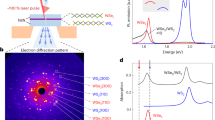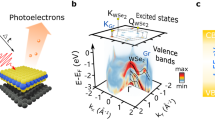Abstract
Van der Waals heterostructures have emerged as promising building blocks that offer access to new physics, novel device functionalities and superior electrical and optoelectronic properties1,2,3,4,5,6,7. Applications such as thermal management, photodetection, light emission, data communication, high-speed electronics and light harvesting8,9,10,11,12,13,14,15,16 require a thorough understanding of (nanoscale) heat flow. Here, using time-resolved photocurrent measurements, we identify an efficient out-of-plane energy transfer channel, where charge carriers in graphene couple to hyperbolic phonon polaritons17,18,19 in the encapsulating layered material. This hyperbolic cooling is particularly efficient, giving picosecond cooling times for hexagonal BN, where the high-momentum hyperbolic phonon polaritons enable efficient near-field energy transfer. We study this heat transfer mechanism using distinct control knobs to vary carrier density and lattice temperature, and find excellent agreement with theory without any adjustable parameters. These insights may lead to the ability to control heat flow in van der Waals heterostructures.
This is a preview of subscription content, access via your institution
Access options
Access Nature and 54 other Nature Portfolio journals
Get Nature+, our best-value online-access subscription
$29.99 / 30 days
cancel any time
Subscribe to this journal
Receive 12 print issues and online access
$259.00 per year
only $21.58 per issue
Buy this article
- Purchase on Springer Link
- Instant access to full article PDF
Prices may be subject to local taxes which are calculated during checkout




Similar content being viewed by others
References
Geim, A. K. & Grigorieva, I. V. Van der Waals heterostructures. Nature 499, 419–425 (2013).
Dean, C. R. et al. Boron nitride substrates for high-quality graphene electronics. Nat. Nanotech. 5, 722–726 (2010).
Mayorov, A. S. et al. Micrometer-scale ballistic transport in encapsulated graphene at room temperature. Nano Lett. 11, 2396–2399 (2011).
Britnell, L. et al. Electron tunneling through ultrathin boron nitride crystalline barriers. Nano Lett. 12, 1707–1710 (2012).
Dean, C. R. et al. Hofstadter’s butterfly and the fractal quantum Hall effect in Moiré superlattices. Nature 497, 598–602 (2013).
Ferrari, A. C. et al. Science and technology roadmap for graphene, related two-dimensional crystals, and hybrid systems. Nanoscale 7, 4598–4810 (2015).
Wang, L. et al. One-dimensional electrical contact to a two-dimensional material. Science 342, 614–617 (2013).
Balandin, A. A. et al. Superior thermal conductivity of single-layer graphene. Nano Lett. 8, 902–907 (2008).
Britnell, L. et al. Strong light–matter interactions in heterostructures of atomically thin films. Science 340, 1311–1314 (2013).
Koppens, F. H. L. et al. Photodetectors based on graphene, other two-dimensional materials and hybrid systems. Nat. Nanotech. 9, 780–793 (2014).
Lopez-Sanchez, O. et al. Light generation and harvesting in a van der Waals heterostructure. ACS Nano 8, 3042–3048 (2014).
Bonaccorso, F. et al. Graphene, related two-dimensional crystals, and hybrid systems for energy conversion and storage. Science 347, 1246501 (2015).
Mics, Z. et al. Thermodynamic picture of ultrafast charge transport in graphene. Nat. Commun. 6, 7655 (2015).
Kim, Y. D. et al. Bright visible light emission from graphene. Nat. Nanotech. 10, 676–681 (2015).
Massicotte, M. et al. Picosecond photoresponse in van der Waals heterostructures. Nat. Nanotech. 11, 42–46 (2016).
Bonaccorso, F., Sun, Z., Hasan, T. & Ferrari, A. C. Graphene photonics and optoelectronics. Nat. Photon. 4, 611–622 (2010).
Caldwell, J. D. et al. Sub-diffractional volume-confined polaritons in the natural hyperbolic material hexagonal boron nitride. Nat. Commun. 5, 5221 (2014).
Dai, S. et al. Tunable phonon polaritons in atomically thin van der Waals crystals of boron nitride. Science 343, 1125–1129 (2014).
Basov, D. N., Fogler, M. M. & Garcia de Abajo, F. J. Polaritons in van der Waals materials. Science 354, 1992 (2016).
Gabor, N. M. et al. Hot carrier-assisted intrinsic photoresponse in graphene. Science 334, 648–652 (2011).
Song, J. C. W. et al. Hot carrier transport and photocurrent response in graphene. Nano Lett. 11, 4688–4692 (2011).
Kampfrath, T. et al. Strongly coupled optical phonons in the ultrafast dynamics of the electronic energy and current relaxation in graphite. Phys. Rev. Lett. 95, 187403 (2005).
Mihnev, M. T. et al. Microscopic origins of the terahertz carrier relaxation and cooling dynamics in graphene. Nat. Commun. 7, 11617 (2016).
Brida, D. et al. Ultrafast collinear scattering and carrier multiplication in graphene. Nat. Commun. 4, 1987 (2013).
Bistritzer, R. & MacDonald, A. H. Electronic cooling in graphene. Phys. Rev. Lett. 102, 206410 (2009).
Song, J. C. W., Reizer, M. Y. & Levitov, L. S. Disorder-assisted electron–phonon scattering and cooling pathways in graphene. Phys. Rev. Lett. 109, 106602 (2012).
Graham, M. W., Shi, S.-F., Ralph, D. C., Park, J. & McEuen, P. L. Photocurrent measurements of supercollision cooling in graphene. Nat. Phys. 9, 103–108 (2013).
Betz, A. C. et al. Supercollision cooling in undoped graphene. Nat. Phys. 9, 109–112 (2013).
Low, T. et al. Cooling of photoexcited carriers in graphene by internal and substrate phonons. Phys. Rev. B 86, 045413 (2012).
Hamm, J. M. et al. Nonequilibrium plasmon emission drives ultrafast carrier relaxation dynamics in photoexcited graphene. Phys. Rev. B 93, 041408 (2016).
Principi, A. et al. Super-Planckian electron cooling in a van der Waals stack. Phys. Rev. Lett. 118, 126804 (2017).
Banszerus, L. et al. Ultrahigh-mobility graphene devices from chemical vapor deposition on reusable copper. Sci. Adv. 1, e1500222 (2015).
Nyquist, H. Thermal agitation of electric charge in conductors. Phys. Rev. 32, 110–113 (1928).
Mihnev, M. T. et al. Electronic cooling via interlayer Coulomb coupling in multilayer epitaxial graphene. Nat. Commun. 6, 8105 (2015).
Tomadin, A. et al. Accessing phonon polaritons in hyperbolic crystals by angle-resolved photoemission spectroscopy. Phys. Rev. Lett. 115, 087401 (2015).
Giuliani, G. F. & Vignale, G. Quantum Theory of the Electron Liquid. (Cambridge Univ. Press, Cambridge, 2005).
Yang, W. et al. A graphene Zener–Klein transistor cooled by a hyperbolic substrate. Nat. Nanotech. https://doi.org/10.1038/s41565-017-0007-9 2017.
Ma, Q. et al. Competing channels for hot-electron cooling in graphene. Phys. Rev. Lett. 112, 247401 (2014).
Jadidi, M. M. et al. Infrared nonlinear photomixing spectroscopy of graphene thermal relaxation. Phys. Rev. Lett. 117, 257401 (2016).
Hwang, E. J., Rossi, E. & Das Sarma, S. Theory of thermopower in two-dimensional graphene. Phys. Rev. B 80, 235415 (2009).
Wunsch, B. et al. Dynamical polarization of graphene at finite doping. New J. Phys. 8, 318 (2006).
Hwang, E. H. & Das Sarma, S. Dielectric function, screening, and plasmons in two-dimensional graphene. Phys. Rev. B 75, 205418 (2007).
Principi, A., Polini, M. & Vignale, G. Linear response of doped graphene sheets to vector potentials. Phys. Rev. B 80, 075418 (2009).
Kotov, V. N. et al. Electron–electron interactions in graphene: current status and perspectives. Rev. Mod. Phys. 84, 1067 (2012).
Alonso-González, P. et al. Acoustic terahertz graphene plasmons revealed by photocurrent nanoscopy. Nat. Nanotech. 2, 31–35 (2017).
Acknowledgements
The authors thank A. Tomadin and F. Vialla for discussions. This work was supported by the European Union’s Horizon 2020 research and innovation programme under grant agreement no. 696656, Graphene Flagship, Fondazione Istituto Italiano di Tecnologia, the Spanish Ministry of Economy and Competitiveness through the Severo Ochoa Programme for Centres of Excellence in R&D (SEV-2015-0522), Fundacio Cellex Barcelona, Mineco grants Ramon y Cajal (RYC-2012-12281), Plan Nacional (FIS2013-47161-P) and the Government of Catalonia through an SGR grant (2014-SGR-1535), ERC StG CarbonLight (307806), ERC grant Hetero2D, and EPSRC grants EP/K01711X/1, EP/K017144/1, EP/N010345/1 and EP/L016087/1. K.-J.T. acknowledges support from a Mineco Young Investigator Grant (FIS2014-59639-JIN). A.P. acknowledges support from ERC Advanced Grant 338957 FEMTO/NANO and from the NWO via the Spinoza Prize. M.M. acknowledges support from the Natural Sciences and Engineering Research Council of Canada (PGSD3-426325-2012). D.T. acknowledges financial support from the European Union Marie Curie Program (Career Integration grant no. 334324 LIGHTER) and the Max Planck Society. K.W. and T.T. acknowledge support from the Elemental Strategy Initiative conducted by the MEXT, Japan and JSPS KAKENHI (grant nos. JP26248061, JP15K21722 and JP25106006).
Author information
Authors and Affiliations
Contributions
K.-J.T. and F.H.L.K. conceived the experiment. K.-J.T. and N.C.H.H. performed the time-resolved photocurrent experiments and performed data analysis. A.P., M.P. and M.B.L. developed the theory and performed calculations on hyperbolic cooling. E.A.A.P. performed the optical pump–probe spectroscopy measurements. Z.M. and K.-J.T. performed the optical pump–THz probe spectroscopy measurements. N.C.H.H., M.B.L., L.B., M.M., P.S., D.D., D.G.P., I.G., G.S. and A.L. fabricated devices. K.W. and T.T. contributed hBN material. M.B., D.T., C.S., A.C.F., G.C., M.P. and F.H.L.K. supervised the work and discussed the results. K.-J.T., F.H.L.K. and M.P. wrote the paper, with input from all authors.
Corresponding authors
Ethics declarations
Competing interests
The authors declare no competing financial interests.
Additional information
Publisher’s note: Springer Nature remains neutral with regard to jurisdictional claims in published maps and institutional affiliations.
Electronic supplementary material
Rights and permissions
About this article
Cite this article
Tielrooij, KJ., Hesp, N.C.H., Principi, A. et al. Out-of-plane heat transfer in van der Waals stacks through electron–hyperbolic phonon coupling. Nature Nanotech 13, 41–46 (2018). https://doi.org/10.1038/s41565-017-0008-8
Received:
Accepted:
Published:
Issue Date:
DOI: https://doi.org/10.1038/s41565-017-0008-8
This article is cited by
-
Electron cooling in graphene enhanced by plasmon–hydron resonance
Nature Nanotechnology (2023)
-
Real-space nanoimaging of hyperbolic shear polaritons in a monoclinic crystal
Nature Nanotechnology (2023)
-
Real-space observation of ultraconfined in-plane anisotropic acoustic terahertz plasmon polaritons
Nature Materials (2023)
-
Signatures of hot carriers and hot phonons in the re-entrant metallic and semiconducting states of Moiré-gapped graphene
Nature Communications (2023)
-
Photocurrent as a multiphysics diagnostic of quantum materials
Nature Reviews Physics (2023)



